
Looking to the north end of Vinegar Hollow.
The long drive from Ithaca to Mustoe completed, we arrived just after dark on New Year’s Eve to a howling wind, snow-covered hills, and an icy terrace. By morning the melt was on, the ice turned to puddles and the snow just feathery patches. But there had been prolonged cold so, while the primrose that flowered last January 1st looked bright green, its buds remained tight. The melt brought mist and drizzle and for a few days we were in a fog bank.
Despite a few injuries, the old collapsed ankle, the new broken wrist, and the sudden onset of a stupefying upper respiratory virus, I took walks with my husband and Belle the dog.
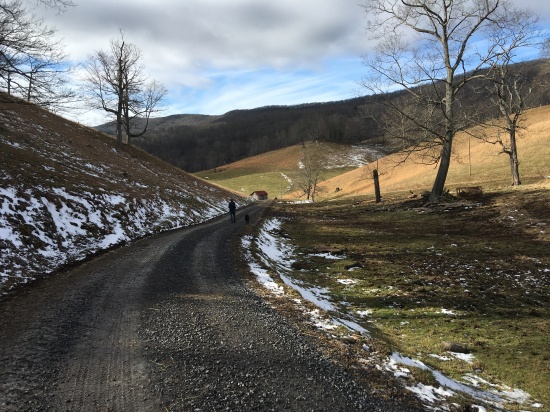
Looking to the south end of Vinegar Hollow.
Trees in winter tell such different stories than those of their summer selves. The old apple trees in the orchard that haven’t been pruned for decades reveal the thicket of watersprouts jutting vertically from almost every horizantal branch. Shoots that spring from the base of a tree are called suckers. They are an important source of regeneration. Arising from latent buds and the result of “weather and other damage” (old age?), watersprouts, on the other hand, make a mess of the interior life of a tree, blocking light and air flow, which in turn decrease the quality of fruit. I remember my mother telling me that the apple tree in the orchard was an old variety called the Northern Spy. I loved the name. Trees do make perfect spies. No one notices them. There are only six left now, each uniquely misshapen.
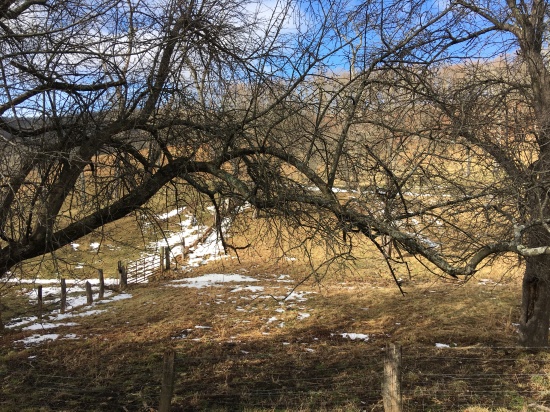
Two old apple trees join branches, heavy with waterspouts.
Another walk takes us up Back Creek Mountain on one of the old logging roads. It’s misty. These woods were logged about 10 years ago. The giants are gone, and the slender trees that remain reach for the sky from the steep hillsides, a maze of toothpicks tilted slightly off vertical. Pale grey green lichens cover their trunks, a contrast to the deep green leaves of the mountain laurel thickets forming the understory. These are Appalachian colors, muted.
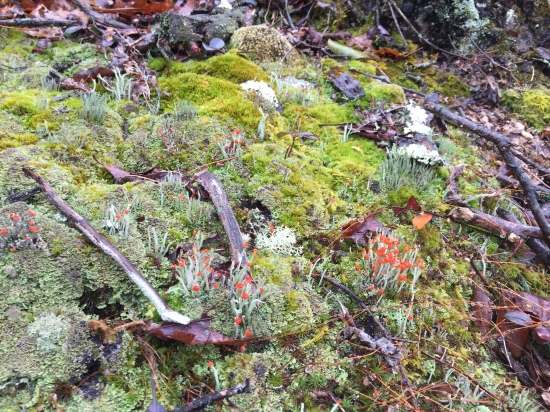
Lichen-and-moss garden along logging road. British soldier lichens are red topped.
There have been other travelers on this road. We notice coyote scat, blunt at one end and pointed at the other, a pale grey brown that blends with the fallen leaves. The British soldiers do not blend in. They are bright and bold, in lime green uniforms and orange red helmets. This seems to be their season as they look fresh and new. Large patches, like miniature gardens, occur frequently along the sides of the trail. The mosses look prosperous also at this time of the year, their green rich and glowing.
We walk up to a large bend and then turn around, retracing our steps. I am thinking about how I love these woods, and that, though they do not have the diversity and flamboyance of a tropical rain forest, there are surprises, like the British soldiers, and undoubtedly there are very beautiful mosses, lichens, and liverworts that have never been named, when I hear a loud “Wow!” I race to catch up with my husband. He is staring at the ground. Even when almost upon him I do not see anything under his gaze. On bended knee, however, I come face to face with a strange life form. As we walk down the trail, we find more and more of them in various stages of development, all of which we had missed on the way up.
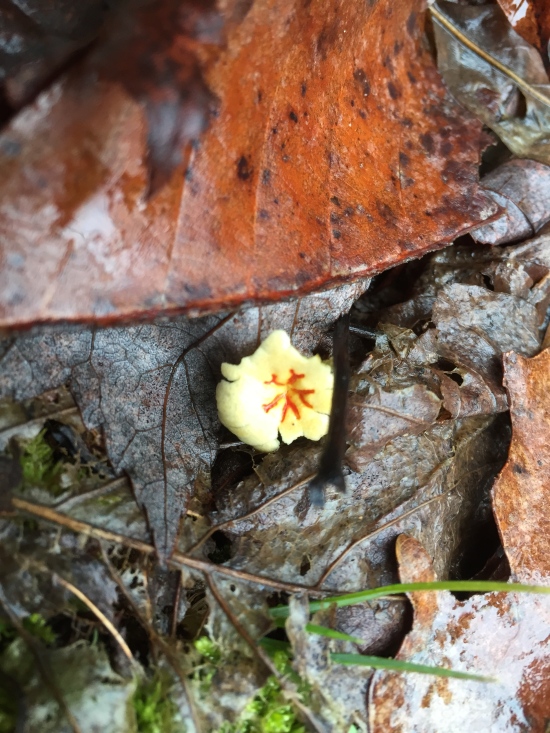
Stage 1 of the yellow-stalked puffball.
The first stage looked like a very small yellow star-like flower flattened on the ground. Next a balloon-like orb appeared underneath the “flower” whose “petals” became a reddish collar around a “mouth” atop the balloon. Tapping the balloon produced a cloud of white dust.
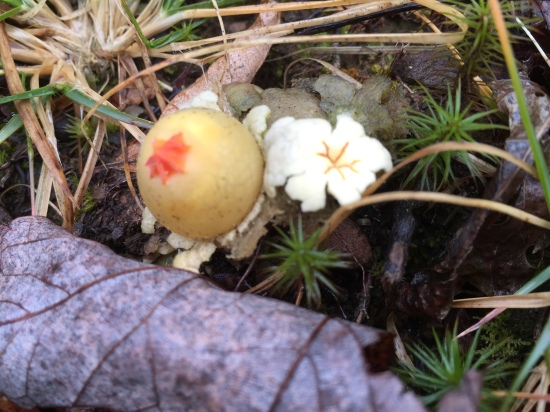
Stage 2 of yellow-stalked puffball: balloon (spore case) has “mushroomed.”
It was so bizarre that I couldn’t see it belonging to any of the five kingdoms of living organisms. But it had to be a mushroom, perhaps related to an earthstar. An Alice-in-Wonderland Google search through the world of bizarre mushrooms led to dead ends until I stumbled on the phrase “stalked puffball,” and then I found it—the yellow-stalked puffball, Calostoma lutescens. It is also called the lattice puffball, apparently for the mesh-like consistency of the stalk.
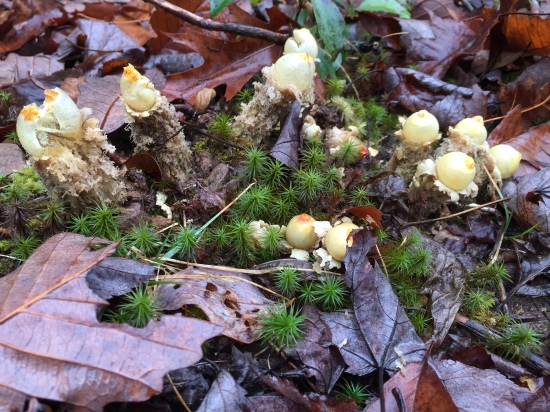

Stage 3 of yellow-stalked puffball: net-like, fibrous stalk elevates “balloon” for spore dispersal.
Michael Kuo of MushroomExpert.com writes that
This distinctive, funky fungus is fairly common in the southern Appalachians, but has been reported from Arkansas to Massachusetts. It looks like a little yellow globe with puckered red lips, sporting a tattered collar, held aloft by an odd pedestal of half-digested pasta. It’s hard to imagine mistaking Calostoma lutescens for anything else.
My Internet search reminded me of Project Noah. It is a site where ordinary people, or citizen scientists, can upload photos for sharing and identification. Someone posted a photo of the yellow-stalked puffball found in North Carolina about a year ago.
For some reason I have always felt the role of reporter or recorder of the hollow’s news, whether about a puffball or water-sprouted old apple trees, as my calling. Why? Why do some people have certain inclinations that seem necessary, like a cosmic job, despite how difficult to honor along with all one’s other responsibilities?
These first few days of January, while thinking determinedly about the yellow-stalked puffball, I read obituaries of John Berger (b. November 5, 1926; d. January 2, 2017), the English writer who spent 43 years living in a small village in the Haute Savoie of the French Alps, in part to chronicle the peasant way of life (he preferred the word peasant to describe the rural worker). In an essay for The Guardian in 2014, he wrote:
What has prompted me to write over the years is the hunch that something needs to be told, and that if I don’t try to tell it, it risks not being told. I picture myself as a stop-gap man rather than a consequential, professional writer.
I take heart from that. One can be a stop-gap writer of or for almost anything. Most would say that Berger was a pretty high-level, stop-gap writer. I think he would affirm that it is ok to be a low-level, stop-gap writer like me. He also said, even when nearing 90, that writing never got any easier for him, though drawing did.
Berger had been an influential art critic, author of Ways of Seeing, but from Quincy in the Haute Savoie, he wrote about the people and their down-to-earth work, making hay, shepherding, and the like. In his essay about the yearly cleaning of his outhouse, “Muck and its Entanglements: Cleaning the Outhouse,” he describes a local schoolroom story of a conversation between a cowpat and a fallen apple. The fallen apple is too pristine to speak to the friendly cowpat. This is his point of departure for seeking meaning in “shit” and the nature of cows:
Perhaps the insouciance with which cows shit is part of their peacefulness, part of the patience that allows them to be thought of in certain cultures as sacred.
Berger also made the observation that cows walk as if on high heels. Their hooves do seem extremely dainty for their ponderous bodies, and I have often wondered that they don’t just topple over on the steep hillsides of Vinegar Hollow. I blame the breeders for their ungainly, top heavy bodies.

They are waiting.
Every time I am here I do some cow watching. Mike, owner of the cows, comes up twice a day with giant hay bales skewered onto the front and back of his John Deere tractor, which he spreads in different parts of the farm, leaving swirling, Celtic patterns, figure-eights of uneaten hay all over the farm.

The cows may seem to vaguely follow his whereabouts, but their attention is not vague. They came up the road more or less single file and stop on the part of the road between the barn and the granary. They stop moving and stand still as statues, no flick of a tail or turning of a head, noses to the north, tails to the south, single file (they are chewing however, as I can make out a rhythmic movement of their jaws), not moving for up to an hour or until they hear a vehicle and then they bound towards the sound, practically scampering. It’s comical, though, if they are in error (if it’s not Mike with their hay bales) because they return to their positions on the road, single file, and wait, chewing, as if they have not been caught dancing about on their high heels to watch the approach of the bales.
It is good for me to start the new year by fitting into the rhythms of Vinegar Hollow. Too soon it will be time to go. I have ordered Pig Earth, the first book in John Berger’s trilogy (Into their Labours) about working with the fiercely independent people who farm the French Alps, in order to understand the rhythms in places where people have worked the land for centuries.

Looking south, through the branches of a young black cherry, on the day of departure.
P.S. Pictures of the puffball were taken by my husband David Fernandez.